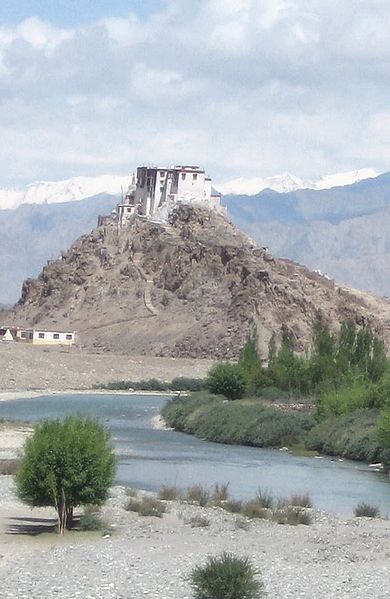Located in one of the world’s most breathtaking landscapes, Ladakh, which literally means the ‘Land of Passes‘, is a site of immense significance for the Buddhists. Flanked by awe-inspiring snow-clad capped peaks of the Himalayas the centuries-old monasteries of Ladakh attract seekers of spiritual enlightenment from all over the world.
Namgyal Tsemo Gompa
 Namgyal Tsemo Gompa / Image Credit: commons.wikimedia.org
Namgyal Tsemo Gompa / Image Credit: commons.wikimedia.orgLocated in the close proximity to the Leh Palace, Namgyal Tsemo Gompa is known for its three storied statue of Maitreya (Chamba) Buddha in a sitting posture.
Thikse Gompa
Thiksey Gompa, Leh / Image Credit: commons.wikimedia.orgSpituk Monastery
Located on a lone rocky hill, the 15th-century Spituk Monastery enshrines the image of Mahakal whose face remains covered throughout the year except during the Spituk festival which is held in January. 8km from Leh, the Spituk Monastery is home to ancient Buddhist artifacts.
Alchi Gompa
 Alchi Gompa / Image credit: wikimedia
Alchi Gompa / Image credit: wikimediaLikir Gompa
Likir Monastery / Image: wikimedia61 km from Leh on the Srinagar - Leh road, Likir Gompa was established in 1065 by Lama Duwag Chosje. Here you will find 1000 year old wall paintings, centuries old bulletproof iron jacket and shield. A small museum in the monastery is an added advantage.
Shey Palace and Monastery
 Shey Palace and Monastery / Image credit: wikimedia
Shey Palace and Monastery / Image credit: wikimedia15 km from Leh, Shey Palace and Monastery is another important gompa in Ladakh. The masterpiece of the Shey monastery is a 7.5 meter statue of Champa or Maitreya Buddha in a seated position.
Phyang Gompa
Phyang Gompa / Image credit: wikimedia
Located on the Leh-Kargil road, Phyang (or Phiyang) gompa was built by king Tashi Namgyal in 1515 and has a rich collection of manuscripts. A large assembly hall is the highlight of this large monastery which belongs to the red sect of the Buddhists. Phyang festival is held on the 28th to 29th of the fifth Tibetan month during July / August.
Hemis Gompa
Hemis Gompa is the centerpiece of any visit to Ladakh. Sitting on a hillock, Hemis Gompa comes lauded as the largest and wealthiest monastery in Ladakh. 45km from Leh, the monastery is adorned with ancient relics. If you want to see the annual Hemis Tsechu festival you will have to come in the months of June and July. During the celebration of the festival which commemorates the birth anniversary of Guru Padmasambhava, the monastery comes alive with the spectacular mask dance by the lamas.
Chemrey Gompa
Chemrey Gompa / Image credit: commons.wikimedia.org45 km from Leh, Chemrey Gompa is located in a picturesque valley leading to Changla. The monastery came into being in 1664 and is dedicated to Sengge Namgyal who had died in 1645. Adjacent to the monastery is a cave believed to have been the abode of 8th century sage Padma Sambhav during his wanderings to spread Buddhism.
Tak-Thog Gompa
 Ancient murals at Thagthok / Image credit: wikimedia
Ancient murals at Thagthok / Image credit: wikimedia50 Km east of Leh, Tak-Thog Gompa is the only monastery belonging to the Nyingmapa set in Ladakh. The foundation is this monastery is traditionally attributed to Guru Rimpoche (Padma Sambhav).
Lamayuru Gompa
125 km from Leh, Lamayaru Gompa can be reached after crossing Fotu La, the highest point on the Srinagar-Leh road, this is the oldest sacred site in Ladakh. Lamayaru gompa was a Bon Shrine before it was converted into a Buddhist monastery.
Stakhna Gompa
Stakna Gompa and Indus River / Image credit: wikimedia20 km from Leh, the Stakhna gompa was founded in 1618 and is one of the oldest monasteries in Ladakh. A few kilometers away from Thikse Gompa, the Stakhna gompa is adorned with beautiful murals and houses statues of Bhutanese lama Zhabthang Rimpoche.
How to Reach Ladakh
Air Located at a height of 3,600m above the sea level, Leh's Bakula Rinpoche Airport is connected by flights with New Delhi.
Rail: The nearest railway station to Ladakh is Jammu Tawi which is 690 km from Leh.
Road: It is advisable to travel to Leh by taking the road from Manali to Leh to enjoy the incredible scenery. Leh is 475km from Manali. Ladakh has an extensive network of good roads.
Best time to Visit Ladakh
May to November is the best time to visit Ladakh.











No comments:
Post a Comment